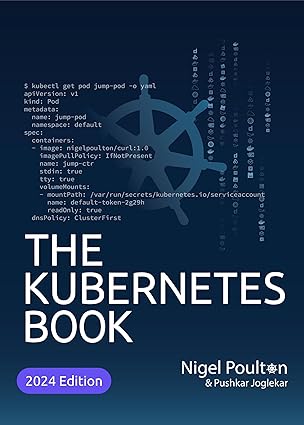This white paper explores the key concepts, technologies, and best practices presented in "The Kubernetes Book: 2024 Edition" by Nigel Poulton. It aims to provide a comprehensive overview of Kubernetes, a leading container orchestration platform, and its critical role in modern software development and deployment.
The Kubernetes Book: 2024 Edition - A Deep Dive
This white paper explores the key concepts, technologies, and best practices presented in "The Kubernetes Book: 2024 Edition" by Nigel Poulton. It aims to provide a comprehensive overview of Kubernetes, a leading container orchestration platform, and its critical role in modern software development and deployment.
1. Introduction
"The Kubernetes Book" serves as a valuable guide for individuals seeking to understand and master Kubernetes. This comprehensive resource delves into the core concepts, architecture, and operational aspects of this powerful platform, empowering readers with the knowledge and skills necessary to effectively manage and deploy containerized applications.
2. Core Concepts of Kubernetes
- Containers: The foundation of Kubernetes, containers provide a lightweight and portable way to package and run applications and their dependencies.
- Orchestration: Kubernetes automates the deployment, scaling, and management of containerized applications across a cluster of machines.
- Key Concepts:
- Pods: The smallest deployable units in Kubernetes, representing a group of one or more containers.
- Deployments: Manage the lifecycle of Pods, ensuring that the desired number of replicas are running and available.
- Services: Define how to access a set of Pods, enabling stable networking for applications.
- Namespaces: Isolate resources within a Kubernetes cluster, providing a way to organize and manage applications.
- Volumes: Provide persistent storage for applications, ensuring data durability across container restarts.
3. Kubernetes Architecture
- Master Node: Controls the state of the cluster, manages worker nodes, and schedules Pods.
- Worker Nodes: Execute Pods and run containerized applications.
- Control Plane: The core of Kubernetes, responsible for managing the cluster state and ensuring that applications run as expected.
4. Key Features and Capabilities
- Scalability and High Availability: Kubernetes provides seamless scaling of applications and ensures high availability through features like self-healing and replication.
- Resource Management: Efficiently manages resources such as CPU, memory, and storage, optimizing resource utilization.
- Service Discovery: Enables applications to easily discover and communicate with each other within the cluster.
- Continuous Integration and Continuous Delivery (CI/CD): Integrates seamlessly with CI/CD pipelines, enabling automated deployments and updates.
- Security: Provides robust security features, including network policies, role-based access control (RBAC), and image scanning.
5. Use Cases
- Microservices Architectures: Deploying and managing microservices applications with high availability and scalability.
- Cloud-Native Applications: Building and deploying applications specifically designed for cloud environments.
- DevOps Practices: Implementing DevOps principles, such as continuous integration and continuous delivery, with Kubernetes.
- Machine Learning and AI: Deploying and scaling machine learning models and AI workloads.
- Edge Computing: Deploying and managing applications at the edge of the network, closer to users and data sources.
6. Tools and Technologies
- kubectl: The command-line interface for interacting with Kubernetes clusters.
- Helm: A package manager for Kubernetes, simplifying the installation and management of applications.
- Docker: A platform for building, shipping, and running containerized applications.
- CI/CD Pipelines: Tools like Jenkins, GitLab CI/CD, and Azure DevOps for automating application deployments.
- Monitoring Tools: Prometheus, Grafana, and other tools for monitoring Kubernetes clusters and application performance.
7. References
- "The Kubernetes Book" by Nigel Poulton
- Kubernetes Documentation: https://www.docker.com/
- CNCF (Cloud Native Computing Foundation):
- Relevant industry blogs and forums: (e.g., Kubernetes blog, CNCF blog, DZone, InfoQ)
8. Conclusion
"The Kubernetes Book" provides a valuable foundation for understanding and mastering Kubernetes. By leveraging the concepts and best practices outlined in this book, individuals can effectively utilize Kubernetes to build, deploy, and manage modern, scalable, and resilient applications in today's dynamic and cloud-native world.
Disclaimer: This white paper provides a general overview of the "Kubernetes Book" and its key concepts. It is not intended to be a substitute for the actual book or professional guidance.
This information is for general knowledge and informational purposes only.
